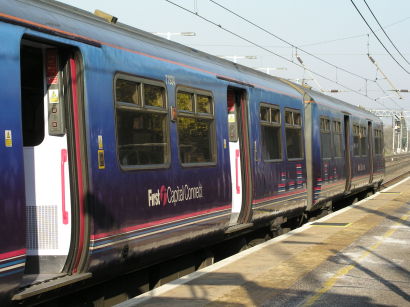THE DEPARTMENT FOR TRANSPORT has admitted that the continuing logjam over the Thameslink rolling stock deal is now jeopardising future electrified services, and has starting the process of procuring new dual-voltage trains elsewhere.
However, the DfT gave Southern the task of announcing the development, even though the new trains involved would be unlikely to enter service until after the Southern franchise had ended in 2015 and been combined with Thameslink.
Southern said it was 'developing proposals with the Department for a new procurement competition for 116 electric (dual voltage) new rolling stock vehicles, with an option for a further 100'.
An option with Bombardier for 40 more Class 377/6 vehicles to be added to the existing order for 130 is also being exercised, which means more work for the Bombardier plant at Litchurch Lane in Derby.
Southern added that 'the new procurement competition will assist the Department's ability to address the wider rolling stock needs of the country'.
The Department for Transport confirmed that cascades to newly-electrified lines were part of the plan. A spokesman told Railnews: "The potential procurement for 116 vehicles and options for a further 100 could enable the early cascade of rolling stock to initiate the delivery of the electrification schemes outlined in HLOS, that would otherwise be delayed because of the current schedule for the delivery of the Thameslink Rolling Stock Programme.”
In fact, the £1.4 billion procurement of some 1,150 vehicles for Thameslink, for which Siemens is the preferred bidder, is still looking uncertain, as rumours persist that the German company is facing difficulties in raising necessary private sector funding because of the crisis in the Eurozone.
Confirmation of the order has been delayed repeatedly, and transport minister Simon Burns admitted at the end of October that the Department was 'assessing options'. He told MPs: "Department officials are working with Siemens to secure financial close early in the new year for the new trains for Thameslink. I am aware of the consequences of failing to conclude the procurement and as you would expect, my Department is closely monitoring progress, including assessing options were it not possible to secure financial close."
Speculation has now started about what role the additional trains would play. The present Southern network would be unlikely to need another 216 vehicles, and the fact that they would be dual-voltage would make them suitable for the core Thameslink route, which involves a change of traction current at Farringdon.
These new trains, no matter who builds them, would need to be sufficiently nimble to help provide the planned peak frequency on the core Thameslink route of 24 trains an hour. Siemens has been developing its Desiro City concept to meet these requirements, by making the trains 25 per cent lighter and giving them enhanced acceleration.
The trains displaced from Thameslink, which presently include 344 Class 319 vehicles, are intended for cascades to lines in the north west of England and also possibly to some suburban routes on the Great Western Main Line. There had been warnings that the delay in procuring new rolling stock for Thameslink could mean that some of these lines would be electrified before any electric trains were available for them.


